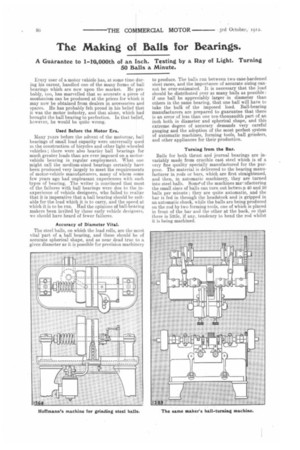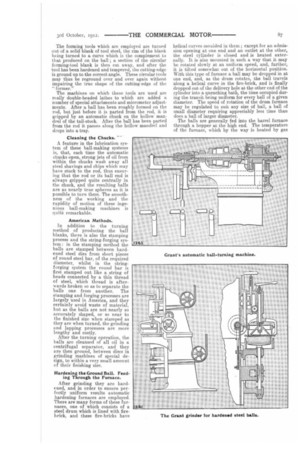The Making of Balls for Bearings.
Page 4

Page 5

Page 6

If you've noticed an error in this article please click here to report it so we can fix it.
A Guarantee to 1-1-0,000th of an Inch. Testing by a Ray of Light. Turning 50 Balls a Minute.
Every user of a motor vehicle has, at some time during his career, handled one of the many forms of ball bearings which are now upon the market. He probably, too, has marvelled that so accurate a piece of mechanism can be produced at the prices for which it may now be obtained from dealers in accessories and spares. He has probably felt proud in his belief that it was the motor industry, and that alone, which had brought the ball bearing to perfection. In that belief, however, he would be quite wrong.
Used Before the Motor Bra.
Many years before the advent of the motorcar, ball bearings of small load capacity were universally used in the construction of bicycles and other light-wheeled vehicles ; there were also heavier ball bearings for much greater loads than are ever imposed on a, motorvehicle bearing in regular employment. What one might call the medium-sized bearings certainly have been produced very largely to meet the requirements of motor-vehicle manufacturers, many of whom some few years ago had unpleasant experiences with such types of bearing. The writer is convinced that most of the failures with ball bearings were due to the inexperience of vehicle designers, who failed to realize that it is imperative that a ball bearing should be suitable for the load which it is to carry, and the speed at which it is to be run, Had the opinions of ball-bearing makers been invited by those early vehicle designers, we should have heard of fewer failures.
Accuracy of Diameter Vital.
The steel balls, on which the load rolls, are the most vital 'part of a ball bearing, and these should be of accurate spherical shape, and as near dead true to a given diameter as it is possible for precision mnehinerv to produce. The balls run between two ease-hardened steel races, and the importance of accurate sizing cannot be over-estimated. It is necessary that the load should be distributed over as many halls as possible : if one ball be appreciably larger in diameter than others in the same bearing, that one ball will have to take the bulk of the imposed load. Ball-bearing manufacturers are prepared to guarantee that there is an error of less than one ten-thousandth part of an inch both in diameter and spherical shape, and this extreme degree of accuracy demands very careful gauging and the adoption of the most perfect system of automatic machines, forming tools, ball grinders, and other appliances for their production.
Turning from the Bar.
Balls for both thrust and journal bearings are invariably made from crucible cast steel which is of a very fine quality specially manufactured for the purpose. The material is delivered to the bearing manufacturer in rods or bars, which are first straightened, and then, in automatic machinery, they are turned into steel balls. Some of the machines ma".ufacturing the small sizes of balls can turn out betwetn 40 and 50 balls per minute ; they are quite automatic, and the bar is fed in through the headstock and is gripped in an automatic chuck, while the balls are being produced on the rod by two forming tools, one of which is placed in front of the bar and the other at the back, so that there is little, if any, tendency to bend the rod whilst it is being machined. The forming tools which are employed are turned out of a solid blank of tool steel, the rim of the blank being turned to a curve which is the complement to that produced on the ball ; a section of the circular forming-tool blank is then cut away, and after the tool has been hardened and tempered, the cutting-edge is ground up to the correct angle. These circular tools may thus be reground over and over again without impairing the true shape of the cutting-edge of the " former."
The machines on which these tools are used are really double-headed lathes to which are added a number of special attachments and micrometer adjustments. After a ball has been roughly formed on the rod, but just before it is parted from the rod, it is gripped by an automatic chuck on the hollow mandrel of the tail-stock. After the ball has been parted from the rod it. passes along the hollow mandrel and drops into a tray.
Cleaning the Chucks.
A feature in the lubrication system of these ball-making systems is, that, each time the automatic chucks open, strong jets of oil from within the chucks wash away all steel shavings and chips which may have stuck to the rod, thus ensuring that the rod or its ball end is always gripped quite centrally in the chuck, and the resulting balls are as nearly true spheres as it is possible to turn them. The smoothness of the working and the rapidity of motion of these ingenious ball-making machines is quit-6 remarkable.
American Methods.
In addition to the turning method of producing the ball blanks, there is also the stamping process and the string-forging system: in the stamping method the balls are stamped between hardened steel dies from short pieces of round steel bar, of the required diameter, whilst in the stringforging system the round bar is first stamped out like a string of beads connected by a thin thread of steel, which thread is afterwards broken so as to separate the balls one from another. The stamping and forging processes are largely used in America, and they certainly avoid waste of material, but as the balls are not nearly so accurately shaped, or so near to the finished size when stamped as they are when turned, the grinding and lapping processes are more lengthy and costly.
After the turning operation, the balls are cleansed of all oil in a centrifugal separator, and they are then ground, between discs in grinding machines of special design, to within a very small amount of their finishing size.
Hardening the Ground Ball. Feeding Through the Furnace.
After grinding they are hardened, and in order to ensure perfectly uniform results automatic hardening furnaces are employed. There are many forms of those furnaces, one of which consists of a steel drum which is lined with firebrick, and these fire-bricks have helical curves moulded in them ; except for an admission opening at one end and an outlet at the other, the steel cylinder is closed and is heated externally. It is also mounted in such a way that it may be rotated slowly at an uniform speed, and, further, it is tilted somewhat out of the horizontal. position. With this type of furnace a ball may be dropped in at one end, and, as the drum rotates, the ball travels along a helical curve in the fire-brick, and is finally dropped out of the delivery hole at the other end of the cylinder into a quenching bath, the time occupied during the transit being uniform for every ball of a given diameter. The speed of rotation of the drum furnace may be regulated to suit any size of ball, a ball of small diameter requiring appreciably less time than does a ball of larger diameter.
The balls are generally fed into the barrel furnace through a hopper at the high end. The temperature of the furnace, which by the way is heated by gas flames, is occasionally tested by means of an electrical pyrometer. The ball races and thrust washers are also heated in automatic furnaces of the type described, or of similar construction which has practically the same effect.
Testing by Limelight. A Clever Scheme.
After they have been hardened, the balls are lapped and polished to the diameter required, and they are then sorted in order to weed out any imperfect ones. The operation of sorting is one which requires very close attention, and this operation for some of the smaller sizes must be carried out in a darkened room, which is provided with but one small light that may be projected on to a tray of balls in a particular direction. When the operator gently shakes the tray of balls the slightest imperfection is detected by the scintillating light on the " fiat " of the imperfect ball. This test for true spherical shape and freedom from flaws, is a most critical one, Sorting and Gauging.
The next operation is the sorting, and for the purpose of sorting each size of ball a specially-made gauge is provided. This gauge consists merely of a steel plate through which a large number of holes are drilled and rettmered. Taking as an example the gauge for
balls of a quarter inch in diameter, the holes in the plate gauge are just too small to allow the balls to drop through. This gauge is plunged into a box or barrel of finished balls, and is withdrawn and given a slight shake ; any balls which are below size will faIl through the holes, whilst any that are the slightest bit above size will stand high enough in the gauge to be detected.
Making the Races.
The making of ball-thrust washers and journal races is not nearly so interesting as the processes through which a steel ball passes in its evolution from the steel bar to the hardened and polished steel ball. Al] thrust washers and ball races are turned from prepared blanks of steel, and the turning process is effected with as little waste of material as is possible. The central portion of a large ball race is cut away by means of a trepanning tool, and may afterwards be used for a ball race of a smaller diameter, this centre portion being again trepanned and used for a still smaller bearing and so on until there is practically nothing left to cut away. It follows, of course, that a most perfect system of limit gauges must. be employed throughout a ball-maker's factory, and all the working gauges must regularly be checked against master gauges which are kept in a measuring room that is maintained at an uniform temperature.






















